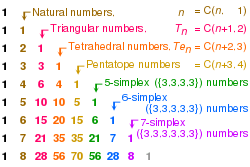Pentatope number
A pentatope number is a number in the fifth cell of any row of Pascal's triangle starting with the 5-term row 1 4 6 4 1 either from left to right or from right to left.

The first few numbers of this kind are:

Pentatope numbers belong to the class of figurate numbers, which can be represented as regular, discrete geometric patterns.[1]
Formula
The formula for the nth pentatope number is represented by the 4th rising factorial of n divided by the factorial of 4:
The pentatope numbers can also be represented as binomial coefficients:
which is the number of distinct quadruples that can be selected from n + 3 objects, and it is read aloud as "n plus three choose four".
Properties
Two of every three pentatope numbers are also pentagonal numbers. To be precise, the (3k − 2)th pentatope number is always the (3k2 − k/2)th pentagonal number and the (3k − 1)th pentatope number is always the (3k2 + k/2)th pentagonal number. The (3k)th pentatope number is the generalized pentagonal number obtained by taking the negative index −3k2 + k/2 in the formula for pentagonal numbers. (These expressions always give integers).[2]
The infinite sum of the reciprocals of all pentatope numbers is 4/3.[3] This can be derived using telescoping series.
Pentatope numbers can also be represented as the sum of the first n tetrahedral numbers:[2]
Relation to single tetrahedral number:
No prime number is the predecessor of a pentatope number, and the largest semiprime which is the predecessor of a pentatope number is 1819.
Similarly, the only primes preceding a 6-simplex number are 83 and 461.
Test for pentatope numbers
We can derive this test from the formula for the nth pentatope number.
Given a positive integer x, to test whether it is a pentatope number we can compute
The number x is pentatope if and only if n is a natural number. In that case x is the nth pentatope number.
Applications
In biochemistry, they represent the number of possible arrangements of n different polypeptide subunits in a tetrameric (tetrahedral) protein.
References
- Deza, Elena; Deza, M. (2012), "3.1 Pentatope numbers and their multidimensional analogues", Figurate Numbers, World Scientific, p. 162, ISBN 9789814355483
- Sloane, N. J. A. (ed.). "Sequence A000332". The On-Line Encyclopedia of Integer Sequences. OEIS Foundation.
- Rockett, Andrew M. (1981), "Sums of the inverses of binomial coefficients" (PDF), Fibonacci Quarterly, 19 (5): 433–437. Theorem 2, p. 435.
- "Wolfram MathWorld site".